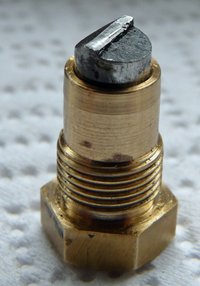 |
 |
 |
Mechanical Lubricator Problems
|
If
you have read the teething troubles page you will have seen that the
mechanical lubricator had been an annoyance to me even before the
Stafford
had
reached the track because of the difficulty of checking the oil level
in it and then trying to fill it with steam oil. The photo
below
shows the lubricator fitted with my new "clip on" lid, but you can see
how close to the underneath of the boiler it was fitted.
Station
Road Steam subsequently modified the design after the first batch of
three locos so that the lubricator was fitted in a better location on
the opposite side of the loco, and at the same time connected its
operating arm to the expansion link as opposed to the slide vale push
rod as shown in the photo. This not only made access easier
but
also ensured that it pumped oil at the same rate regardless of the
amount the reversing lever was notched back. Sadly this
modification was not backwards compatible so it could not be fitted to
my Stafford. Another slight annoyance was that the oil
capacity
was relatively low so that it required checking, and filling up, at
regular intervals which was an inconvenience during hectic public
running.. NOTE: Station Road Steam are now fitting their own design of lubricator to replace the "bought in" item fitted to my Stafford which has overcome all the problems I have encountered. |
|||||
  Mechanical
Lubricator Failure Mechanical
Lubricator FailureApart from the minor irritation of the limited oil capacity I had no problems with the lubricator until the Stafford had covered about 45 miles. It was during the afternoon of a public running day at Pinewood when I noticed during a routine check that the lubricator oil level had not dropped as would have been expected. A quick check showed that when operated by hand it was still pumping oil so for the rest of the afternoon the handle was given a few turns every time the loco reached the station, but this highlighted the problem with reaching the manual operating crank which was on the inside of the lubricator right underneath the boiler. As the afternoon runs continued other club members watched the loco for me as I drove past and noticed that the manual operating crank was not rotating as the loco ran along, so we knew that the problem was with the lubricator drive system. Once home the problem was traced to the pawl, shown on the right, which formed part of the lubricator drive mechanism. It should have a nice sharp pointed edge where the photo shows the shiny flat section running across the top. It didn't take long for Station Road Steam to discuss the problem with their supplier and to find out that somehow the pawl had never been hardened properly, so within a few days I received a new pawl. But unfortunately the problems didn't end there as with the new pawl fitted the lubricator still failed to pump oil when the loco was running on the track. No matter how we adjusted the operating arm the lubricator would only pump oil when it was operating at very low speeds i.e. when you pushed the loco along to test the lubricator. As soon as the loco got up to a slow running speed on the track it stopped working again. My theory (which was not proven) was that the design of the pawl was faulty because the black pawl had to slide in the brass housing to operate. It was quite a close fit in the brass and only had a small spring behind it to push it forward, but as there were no "breather" holes through the brass behind the pawl I could envisage hydraulic locks occurring which could easily stop the pawl from moving. After a day of frustration I decided to scrap the entire lubricator and made one myself, but you can read about that on the Functional Modifications pages. |
||||||